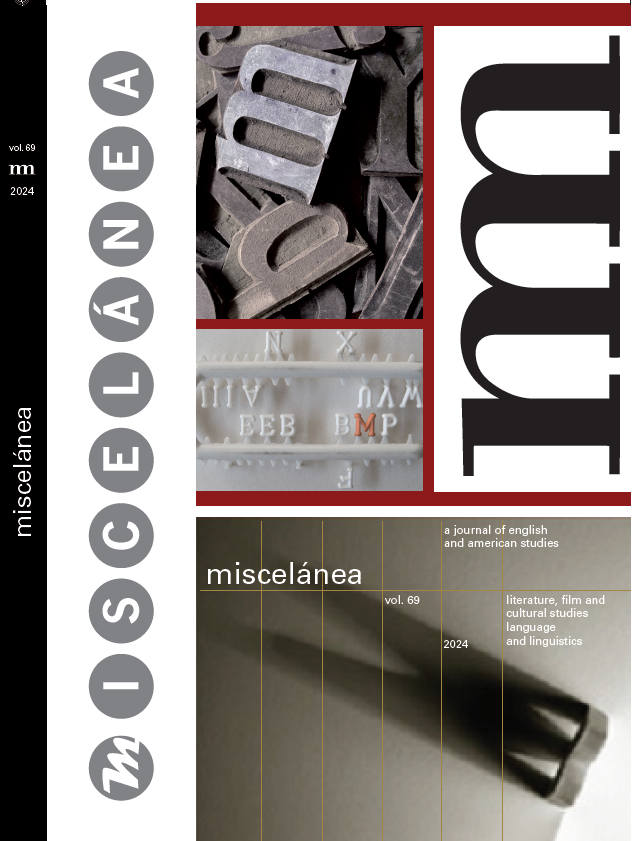Disponibilidad léxica en AICLE multilingüe: Diferencias dependientes del género en inglés y francés
DOI:
https://doi.org/10.26754/ojs_misc/mj.20249559Palabras clave:
aprendizaje integrado de contenidos y lenguas extranjeras, género, disponibilidad léxica, inglés como lengua extranjera, francés como lengua extranjeraResumen
Se ha indicado que el Aprendizaje Integrado de Contenidos y Lenguas Extranjeras (AICLE) tiene efectos positivos en el aprendizaje del vocabulario relacionado con el contenido. No obstante, aunque el AICLE haya crecido a gran escala por toda España, la gran mayoría de los programas se imparten en inglés y se han desatendido en gran medida los idiomas distintos del inglés. Por eso, se ha hecho un llamamiento a la investigación comparativa de diferentes lenguas meta, con el fin de comprender las fortalezas y debilidades de AICLE independientemente de la lengua del programa. Además, la investigación sobre género y disponibilidad léxica ha comprobado que las alumnas suelen obtener mejores promedios de respuestas que los alumnos. Sin embargo, dado que se ha sugerido que un contexto AICLE tiene la capacidad de desdibujar las diferencias de género, se necesita más investigación para entender si la instrucción AICLE afecta a esta ventaja, o si los alumnos y las alumnas obtienen promedios parecidos. Por consiguiente, este estudio pretende analizar la disponibilidad léxica en un contexto AICLE para determinar si existe una ventaja en inglés y si esta ventaja depende del género. Los resultados indican diferencias claras entre la disponibilidad en inglés y francés, con ventaja del inglés, independientemente del género. No obstante, un análisis transversal indica que la instrucción AICLE tiene un fuerte impacto en la disponibilidad léxica en cada idioma, pero de manera distinta para las chicas y los chicos. Los hallazgos son de suma importancia para quienes quieran apoyar a las alumnas y los alumnos en un aula multilingüe.
Descargas
Citas
AGUSTÍN LLACH, María del Pilar and Almudena FERNÁNDEZ FONTECHA. 2014. “Lexical Variation in Learners’ Responses to Cue Words: The Effect of Gender”. In Jiménez Catalán, Rosa María (ed.): 69-81. <https://doi.org/10.1007/978-94-007-7158-1_5>.
CANGA ALONSO, Andrés. 2017. “Spanish L1 Speakers’ and EFL Learners’ Available Lexicon”. Anuario de Estudios Filológicos 40: 5-23. <https://doi.org/10.17398/2660-7301.40.5>.
DALTON-PUFFER, Christiane. 2008. “Outcomes and Processes in Content and Language Integrated Learning (CLIL): Current Research from Europe”. In Delanoy, Werner and Laurenz Volkmann (eds.) Future Perspectives for English Language Teaching. Heidelberg: Carl Winter: 139-157.
DALTON-PUFFER, Christiane. 2011. “Content-and-Language Integrated Learning: From Practice to Principles?” Annual Review of Applied Linguistics 31: 182-204. <https://doi.org/10.1017/S0267190511000092>.
DÖRNYEI, Zoltán. 2007. Research Methods in Applied Linguistics. Oxford: Oxford U.P.
DÖRNYEI, Zoltán and Ali H. AL‐HOORIE. 2017. “The Motivational Foundation of Learning Languages other than Global English: Theoretical Issues and Research Directions”. The Modern Language Journal 101 (3): 455-468. <https://doi.org/10.1111/modl.12408>.
FERNÁNDEZ FONTECHA, Almudena. 2010. “Gender and Motivation in EFL Vocabulary Production”. In Jiménez Catalán, Rosa María (ed.) Gender Perspectives on Vocabulary in Foreign and Second languages. London: Palgrave Macmillan: 93-117. <https://doi.org/10.1057/9780230274938_5>.
FERNÁNDEZ ORÍO, Susana and Rosa María JIMÉNEZ CATALÁN. 2015. “Lexical Availability of EFL Learners at the End of Spanish Secondary Education: The Effect of Language Program and Prompt”. ES Revista de Filología Inglesa 36: 103-127.
GALLARDO-DEL-PUERTO, Francisco and Zeltia BLANCO-SUÁREZ. 2021. “Foreign Language Motivation in Primary Education Students: The Effects of Additional CLIL and Gender”. Journal of Immersion and Content-based Language Education 9 (1): 58-84. <https://doi.org/10.1075/jicb.19023.gal>.
GRADDOL, David. 2006. English Next. UK: British Council.
HERAS, Arantxa and David LASAGABASTER. 2015. “The Impact of CLIL on Affective Factors and Vocabulary Learning”. Language Teaching Research 19 (1): 70-88. <https://doi.org/10.1177/1362168814541736>.
JIMÉNEZ CATALÁN, Rosa María. 2014a. “Preface”. In Jiménez Catalán, Rosa María (ed.): v-ix.
JIMÉNEZ CATALÁN, Rosa María. (ed.) 2014b. Lexical Availability in English and Spanish as a Second Language. Dordrecht: Springer. <https://doi.org/10.1007/978-94-007-7158-1>.
JIMÉNEZ CATALÁN, Rosa María and María del Pilar AGUSTÍN LLACH. 2017. “CLIL or Time? Lexical Profiles of CLIL and non-CLIL EFL Learners”. System 66: 87-99.
JIMÉNEZ CATALÁN, Rosa María and Andrés CANGA ALONSO. 2019. “El Léxico Disponible en Inglés de Chicos y Chicas Españoles Adolescentes”. ELIA: Estudios de Lingüística Inglesa Aplicada 19: 157-176.
JIMÉNEZ CATALÁN, Rosa María and Tess FITZPATRICK. 2014. “Frequency Profiles of EFL Learners’ Lexical Availability”. In Jiménez Catalán, Rosa María (ed.): 83-100. <https://doi.org/10.1007/978-94-007-7158-1_6>.
JIMÉNEZ CATALÁN, Rosa María and Julieta OJEDA ALBA. 2009. “Girls’ and Boys’ Lexical Availability in EFL”. ITL International Journal of Applied Linguistics 158: 57-76. <https://doi.org/10.2143/ITL.158.0.2046920>.
LASAGABASTER, David. 2008. “Foreign Language Competence in Content and Language Integrated Courses”. The Open Applied Linguistics Journal 1: 30-41. <https://doi.org/10.2174/1874913500801010030>.
LYSTER, Roy and Susan BALLINGER. 2011. “Content-Based Language Teaching: Convergent Concerns across Divergent Contexts”. Language Teaching Research 15 (3): 279-288. <https://doi.org/10.1177/1362168811401150>.
MARTÍNEZ-ADRIÁN, María and Francisco GALLARDO-DEL-PUERTO. 2017. “The Effects of Language Typology on L2 Lexical Availability and Spelling Accuracy”. International Journal of English Studies 17 (2): 63-79. <https://doi.org/10.6018/ijes/2017/2/256411>.
NEILSON PARADA, Maryann. 2016. Lexical Availability in Diaspora Spanish: A Cross-generational Analysis of Chilean Swedes. PhD Dissertation. University of Illinois at Chicago, USA.
SAN ISIDRO, Xabier. 2018. “Innovations and Challenges in CLIL Implementation in Europe”. Theory into Practice 57 (3): 185-195. <https://doi.org/10.1080/00405841.2018.1484038>.
SANDU, Bianca Manuela and Konstantina KONSTANTINIDI. 2021. “Impact of Overseas Experience on Lexical Availability in English and Spanish as Foreign Languages”. In Barragán Martín, Ana Belén, María del Mar Molero Jurado, África Martos Martínez, María del Mar Simón Márquez, José Jesús Gázquez Linares and María del Carmen Pérez Fuentes (eds.) Innovación Docente e Investigación en Arte y Humanidades: Nuevos Enfoques en la Metodología Docente. Madrid: Dykinson: 1049-1058. <https://doi.org/10.2307/j.ctv2gz3whg.96>.
SANTOS DÍAZ, Inmaculada Clotilde. 2017. “Selección del Léxico Disponible: Propuesta Metodológica con Fines Didácticos”. Porta Linguarum: Revista Internacional de Didáctica de las Lenguas Extranjeras 27: 122-139. <https://doi.org/10.30827/Digibug.53965>.
SCHMITT, Norbert. 2000. Vocabulary in Language Teaching. Cambridge: Cambridge U.P.
ŠIFRAR KALAN, Marjana. 2014. “Slovene Students’ Lexical Availability in English and Spanish”. In Jiménez Catalán, Rosa María (ed.): 125-138. <https://doi.org/10.1007/978-94-007-7158-1_8>.
WEI, Li and Melissa G. MOYER. 2009. The Blackwell Guide to Research Methods in Bilingualism and Multilingualism. Oxford: Blackwell. <https://doi.org/10.1002/9781444301120.ch22>.
Descargas
Publicado
Cómo citar
Número
Sección
Licencia
Derechos de autor 2024 Leah Geoghegan

Esta obra está bajo una licencia internacional Creative Commons Atribución-NoComercial 4.0.
Aceptado 2023-11-09
Publicado 2024-06-24


